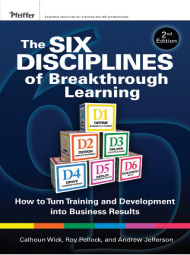By Calhoun Wick, Roy Pollock, and Andrew Jefferson
 With a strong focus on how learning assists an organization, this book gives beginning-to-end support for using learning-training-development initiatives to achieve strong business results.
With a strong focus on how learning assists an organization, this book gives beginning-to-end support for using learning-training-development initiatives to achieve strong business results.
There are no isolated training events here. All six of the disciplines are pointed toward ensuring that what people learn will:
- Be essential for the organization
- Transfer to the job.
Plus, if we follow these disciplines, we’ll be able to show just how the intervention we’ve provided is doing. In other words, did we get the results we wanted?
Discipline Notes
Here are a few words about each of the six disciplines:
1 Define Business Objectives. Where to start? Here’s the thing: We offer training, not because it’s inherently good to offer training, but because we’re looking for a larger result for the organization. An improvement in performance. Great support here for looking at learning and training from a wider view, and then letting that performance focus drive our learning initiatives.
2 Design the Complete Experience. Don’t think of training as something that happens in a day or two or a week or two. Consider a much longer timeframe. Get the managers involved ahead of time. Set expectations. Provide pre-work. Deliver the program. Follow up. Include time working with new skills on the job as part of the learning experience. After some time has passed, assess how people are doing with their new skills on the job. Celebrate success.
3 Deliver for Application. Design for relevance. Make the rationale clear. Make sure everything is connected to what matters for the business. Transfer is essential: if learners don’t apply what they learn, then we won’t see the improved performance we said we needed.
4 Drive Learning Transfer. Avoid “learning scrap.” Actively promote transfer in the organization. Build a support process. Enlist managers, coaches. Set objectives beyond the learning event. Remind participants and managers of their accountability for action in the workplace. Recognize progress.
5 Deploy Performance Support. Provide materials and human support to ensure that the learners can more easily use what they’ve learned. Job aids. Performance support systems. Feedback, collaboration, coaching.
6 Document Results. Show how your learning initiatives add value. How’s it going? Collect and analyze data. If things aren’t improving as expected, make adjustments and measure progress again. Share your successes in a compelling way.
Every designer and training manager should have this book. Organization development and human resources professionals will find it useful, too. It does an excellent job of tying learning initiatives to business results. The focus is on how businesses function and how training and development can assist. Cal, Roy, and Andrew have captured the key: learning programs are only worth doing if they provide value. They do a great job of illustrating how to make that happen.
Resources
Book | The Six Disciplines of Breakthrough Learning
Post | No Naked Training
Post | Where Do I Start?
